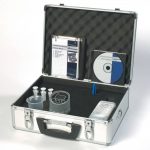The rapid speed of change within the shipping industry, incorporating new eco technologies and measures, has been a development worth celebrating. It has not, however, come free of the negative consequences of positive change. By from Parker Kittiwake
Longer piston strokes in new generation, fuel-efficient engines can bring one such consequence: water condensation collects on the surfaces[ds_preview] of cylinder liners, which reacts with sulphur dioxide in combustion gasses, leading to the formation of sulphuric acid and resulting in corrosion on the liner surface. The resulting iron compounds formed are flushed into the cylinder oil, leading to excessive wear of the cylinder liner.
1. Over-lubricating to tackle cold corrosion
To target increased acidity within the cylinder liner, increasing the feed rate of an alkaline lubricant is one obvious solution – and a short term one when operating costs climb, as lubricant oil is over-applied. With often four times the normal of level of required lubricant being used, this amounts to a substantial cost. In this efficiency-conscious era, minimising both fuel and lube oil consumption is high on the agenda. Even a 0.1g/kWh reduction in cylinder oil dosage represents a significant yearly saving for the owner. Successful feed rate optimisation relies upon identifying exactly how much cylinder lube oil injection can be acceptably reduced to achieve the optimum operating conditions.
2. Monitoring to optimise feed rate Laboratory analysis
Historically port inspection and more recently laboratory testing of scrapedown oils has been the primary method used to inform adjustment of lubrication levels. Each of the oil majors provides a drain oil analysis programme; for example, Exxon Mobil’s Signum Oil Analysis and Shell’s Rapid Lubricants Analysis heighten savings by monitoring the engine in order
to determine its sensitivity to particular parameters, optimise lube oil feed rate, and improve maintenance management and extension of overhaul periods. Used by nearly 500 ships worldwide, the service from Flame Marine is perhaps the best-known independent provider of detailed diagnostics. The company estimates that over-lubrication of cylinder lubricating oil in slow speed two stroke marine diesel engines can cost ship owners and ship managers over 100,000$ per year and per ship. To address this, their service reduces feed rates by monitoring the performance characteristics of the engine and the chemical composition of the cylinder drain oil, analysing this information to provide a comprehensive report covering the combustion
process, cylinder oil feed rates, fuel bunkered as well as identification of potential issues such as piston and liner wear, incomplete combustion, piston misalignment, reliability of assessments as well as the fuel system and crankcase system oil.
The main challenges of adopting this approach in isolation are two-fold. Firstly, useful results depend entirely upon testing a representative sample. In today’s shipping industry, skilled, reliable and experienced engineers who understand how and where to draw a sample are no longer necessarily »the norm«. Secondly, although comprehensive and detailed information is collected, it comes with an inherent delay, which means a critical and costly repair opportunity could be inadvertently missed.
Electronically-controlled lubricating systems
Electronically-controlled lubricating systems provide the next step in meeting demands for lower cylinder oil feed rates. The MAN Alpha Lubricator, Wärtsilä’s Pulse Lubricating System (PLS) and Hans Jensen SIP system all aim to inject cylinder oil into the cylinder at the exact position and time where the effect is optimal. These systems have achieved significant savings, for example the guide feed rate for Wärtsilä RTA and RT-flex engines equipped with the Pulse Lubrication System as original equipment is 0.7–0.8 g/kWh of cylinder lubricating oil when previously the average would have been 1–1.2 g/kWh. Employing an electronic lubrication system enables significant reduction in cylinder oil consumption, but it is an open loop system and therefore does not provide feedback on the impact of this reduction. As it is not an exact science, sensibly, a safety buffer is often applied. This is because without a reliable feedback system to accurately monitor the effect on the engine, changing feed rates solely based on OEM recommendations could increase the associated wear caused by lack of lubrication and seriously harm the engine. Further savings could likely be secured depending on load, temperature and humidity for example, but to penetrate the lubrication safety buffer, safely achieve the true optimum feed rate and realise maximum savings, offline or online tools are available to closely monitor lubrication conditions.
Offline tools
The Shell Onboard Alert and Exxon Mobil Scrapedown Analyser are portable, touch screen devices, helping monitor cylinder liner wear by providing daily onboard measurement and recording of metallic iron content in scrape down oil. Although wear rate is monitored by measuring magnetic iron particles, these devices do not monitor corrosive iron oxide particles. To manage this, Total Base Number should be measured post fuel switching, ensuring sufficient additive content.
Online tools
Dependent upon trade, load, running hours and other factors, constant real-time monitoring is the ultimate tool for safely optimising cylinder lube oil feed rate and, as a result, improving efficiency, decreasing lubricant costs and avoiding issues related with over- and under-lubrication. Kittiwake’s LinerSCAN is being used by companies such as AP Moller-Maersk Group, Hapag-Lloyd, Ernst Russ and Reederei F. Laeisz to inform feed rate reduction and achieve maximum penetration of the lubrication safety buffer.Using magnetometry to quantify the iron in used cylinder oil, the LinerSCAN sensors are fitted to each cylinder of the vessel engine and report changes caused by abrasive wear, highlighting periods of increased physical or thermal stress. This provides a better understanding of the factors influencing cylinder liner wear, to monitor change trends and see wear developing. Importantly, by monitoring wear particles in real time, engineers are alerted to escalating cylinder liner damage and are able to react quickly to changes, enabling preventative maintenance during the ship’s passage to the next port and insuring against costly ship downtime.
Not only can LinerSCAN be used to optimise lubricant feed rate, it also minimises liner wear, improves maintenance scheduling, decreases sampling and testing costs, and detects ingress of catalyst fines. With fuel testing agencies continuing to correlate declining sulphur levels, increasing levels of catalyst fines and subsequent engine damage, online testing to safeguard vessels from costly engine damage has never been more important.
The LinerSCAN system is particularly useful for reducing the risk of high wear in unfamiliar environments or situations, such as areas of high humidity where water enters the combustion chamber with the air from the turbo charger, disturbs the oil film and leads to wear and scuffing, endangering the liner. When used in conjunction with the Parker Kittiwake Cold Corrosion Test Kit, the shipowner will receive the most comprehensive analysis of corrosive wear in cylinder lubricants, with the Test Kit providing a measurement of non-ferrous iron compounds present in a sample almost instantly, negating the need to send samples to a laboratory for analysis and avoiding the time and cost this incurs. By having quick and simple access to this information onboard, operators can easily identify where adjustments need to be made to alter the operating conditions within the cylinder in order to minimise corrosive wear and reduce cost. The Test Kit, when used alongside ferro-magnetic analysers, will indicate the levels of both metallic and non-metallic iron compounds so that operators can isolate and address the different processes which result in these corrosive elements being formed. Many OEMs are now advocating the use of higher BN lubricants in engines with a longer stroke and so it becomes more important to monitor the cylinder oil to understand the effects of this change on the conditions within the cylinder chamber. Scrape down oil is continually exposed to acidic combustion products that need to be neutralised before they corrode engine parts. By frequently testing the residual BN of used cylinder lubricant, operators can ensure that alkaline reserve levels within the oil are sufficient to neutralise these acidic products. Parker has recently updated the Digi TBN Test Kit which measures the residual BN levels in used cylinder oil, providing an onboard figure in minutes. This allows operators to monitor the efficiency of cylinder lubricants over a long period of time, maximising the potential life of the product as well as saving both the time and cost incurred with repairs resulting from corrosive damage.
3. Optimise not compromise
Effective feed rate optimisation is not based on a single test at a fixed point in time – it is a dynamic, ongoing exercise. For this reason, achieving the optimal feed rate without damaging the engine relies upon a combination of traditional methods with a reliable, real time feedback system. You may certainly adjust lubrication according to the OEM’s instructions, though the risk may become apparent at a later date, when you notice the loss of more liners. With an average insurance claim for unexpected liner loss at over 250,000 $, this realisation comes at a price.
Dr. Steve Dye





















